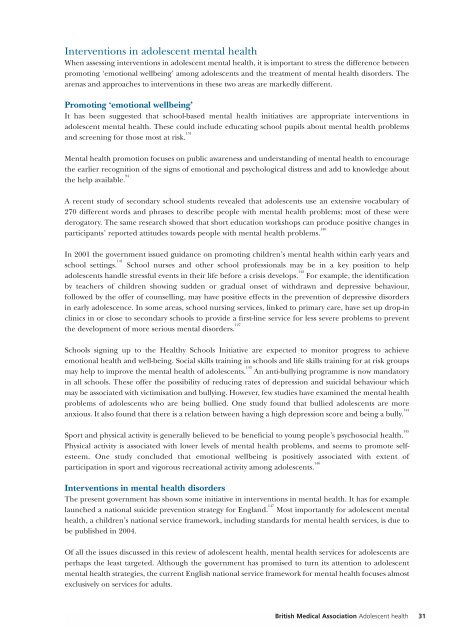Alcohol misuse: tackling the UK epidemic - London
Alcohol misuse: tackling the UK epidemic - London
Alcohol misuse: tackling the UK epidemic - London
Create successful ePaper yourself
Turn your PDF publications into a flip-book with our unique Google optimized e-Paper software.
Interventions in adolescent mental health<br />
When assessing interventions in adolescent mental health, it is important to stress <strong>the</strong> difference between<br />
promoting ‘emotional wellbeing’ among adolescents and <strong>the</strong> treatment of mental health disorders. The<br />
arenas and approaches to interventions in <strong>the</strong>se two areas are markedly different.<br />
Promoting ‘emotional wellbeing’<br />
It has been suggested that school-based mental health initiatives are appropriate interventions in<br />
adolescent mental health. These could include educating school pupils about mental health problems<br />
and screening for those most at risk. 131<br />
Mental health promotion focuses on public awareness and understanding of mental health to encourage<br />
<strong>the</strong> earlier recognition of <strong>the</strong> signs of emotional and psychological distress and add to knowledge about<br />
<strong>the</strong> help available. 94<br />
A recent study of secondary school students revealed that adolescents use an extensive vocabulary of<br />
270 different words and phrases to describe people with mental health problems; most of <strong>the</strong>se were<br />
derogatory. The same research showed that short education workshops can produce positive changes in<br />
participants’ reported attitudes towards people with mental health problems. 140<br />
In 2001 <strong>the</strong> government issued guidance on promoting children’s mental health within early years and<br />
school settings. 141<br />
School nurses and o<strong>the</strong>r school professionals may be in a key position to help<br />
adolescents handle stressful events in <strong>the</strong>ir life before a crisis develops. 142<br />
For example, <strong>the</strong> identification<br />
by teachers of children showing sudden or gradual onset of withdrawn and depressive behaviour,<br />
followed by <strong>the</strong> offer of counselling, may have positive effects in <strong>the</strong> prevention of depressive disorders<br />
in early adolescence. In some areas, school nursing services, linked to primary care, have set up drop-in<br />
clinics in or close to secondary schools to provide a first-line service for less severe problems to prevent<br />
<strong>the</strong> development of more serious mental disorders. 127<br />
Schools signing up to <strong>the</strong> Healthy Schools Initiative are expected to monitor progress to achieve<br />
emotional health and well-being. Social skills training in schools and life skills training for at risk groups<br />
may help to improve <strong>the</strong> mental health of adolescents. 143<br />
An anti-bullying programme is now mandatory<br />
in all schools. These offer <strong>the</strong> possibility of reducing rates of depression and suicidal behaviour which<br />
may be associated with victimisation and bullying. However, few studies have examined <strong>the</strong> mental health<br />
problems of adolescents who are being bullied. One study found that bullied adolescents are more<br />
anxious. It also found that <strong>the</strong>re is a relation between having a high depression score and being a bully. 144<br />
Sport and physical activity is generally believed to be beneficial to young people’s psychosocial health. 145<br />
Physical activity is associated with lower levels of mental health problems, and seems to promote selfesteem.<br />
One study concluded that emotional wellbeing is positively associated with extent of<br />
participation in sport and vigorous recreational activity among adolescents. 146<br />
Interventions in mental health disorders<br />
The present government has shown some initiative in interventions in mental health. It has for example<br />
launched a national suicide prevention strategy for England. 147<br />
Most importantly for adolescent mental<br />
health, a children’s national service framework, including standards for mental health services, is due to<br />
be published in 2004.<br />
Of all <strong>the</strong> issues discussed in this review of adolescent health, mental health services for adolescents are<br />
perhaps <strong>the</strong> least targeted. Although <strong>the</strong> government has promised to turn its attention to adolescent<br />
mental health strategies, <strong>the</strong> current English national service framework for mental health focuses almost<br />
exclusively on services for adults.<br />
British Medical Association Adolescent health 31
















